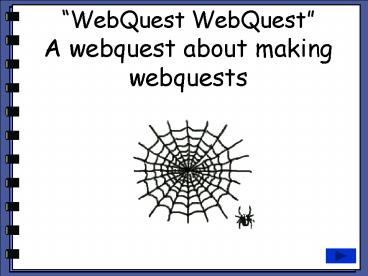WebQuest WebQuest A webquest about making webquests - PowerPoint PPT Presentation
1 / 13
Title:
WebQuest WebQuest A webquest about making webquests
Description:
Creating a Webquest: It's easier than you think. Video: ... Step 2: Choose your learning objectives: Discuss with your group which SOL need to be covered. ... – PowerPoint PPT presentation
Number of Views:287
Avg rating:3.0/5.0
Title: WebQuest WebQuest A webquest about making webquests
1
WebQuest WebQuestA webquest about making
webquests
2
Intro
Congratulations, youve been named TEACHER OF
THE YEAR! Well, get ready because your
principal has chosen you to showcase
project-based learning and technology
integration for next weeks visitor THE STATE
SECRETARY OF EDUCATION.
3
Task
Your teams job is to create a webquest that your
students can use during the week of the
Secretarys visit. You will choose a topic
that addresses one or more SOL objectives.
You will develop a task that allows students to
demonstrate understanding of a concept and/or
development of a skill. You will create a
rubric to use to evaluate students. Your
webquest must include the six components that you
see in this webquest.
4
Process ?
- Step 1 Learn about web quests
- What are they?
- What is a Webquest?
- What is a Webquest II?
- Building Blocks
- Annotated Template
- A webquest about webquests
- Creating a Webquest Its easier than you think
- Video Designing and Using Webquests
- Video Teaching Webquests in 6th Grade
5
Process (cont.) ?
- Step 1 (cont.) Learn about web quests
- Why use them?
- Why Use Webquests?
- Why Use Webquests with My Class?
- Where can I find some examples?
- Webquest.com
- Education World Webquest Archives
- Best Webquests.com
6
Process (cont.) ?
- Step 1 (cont.) Learn about webquests
- Where can I get some pointers?
- The webquest design process
- Adapting and Enhancing Existing webquests
- Webquest taxonomy A taxonomy of tasks
- Process checklist
- Rubric Samples Primary, Elementary , Secondary
- Rubric Template
- Fine Points Little things that make a difference
7
Process (cont.) ?
- Step 2 Choose your learning objectives
- Discuss with your group which SOL need to be
covered. - Are you going to address one SOL or multiple SOL?
- What is your essential or guiding question?
- Are you going to introduce a new concept/skill or
reinforce something that has already been taught.
8
Process (cont.) ?
- Step 3 Select a design template
- After clicking the link that follows, open and
save the preferred template in a suitable
location Powerpoint or HTML. - Step 4 Choose roles (adapt to meet your needs)
- One team member writes the introduction, task,
and conclusion. - One team member creates the rubric.
- One team member begins developing the process
(i.e. learning activities, with and without
technology) and finding resources. - As team members complete their tasks, the team
should come together to review and revise their
work. - All team members should eventually come together
to complete the development of the project.
9
Process (cont.) ?
- Step 5 Put it all together
- Polish it up.
- Add graphics.
- Make necessary revisions.
- Create a draft of the teacher page.
- Step 6 Present your webquest to your students
- Elicit questions.
- Make last minute revisions.
- Schedule time for students to complete the
project. - Assess project and revise for future use,
including any necessary modifications to the
teacher page. - Notify your ITRT that your webquest is ready to
be evaluated.
10
Evaluation ?
11
Evaluation (cont.)
12
Conclusion
Teachers should find developing and using
webquests both satisfying and exhausting. Most
of the work is front loaded providing valuable
time for the teacher to take on the roles of
facilitator, guidance counselor, cheerleader,
traffic cop, and evaluator. Increased student
engagement, achievement, and positive interaction
should replace student apathy, isolation, and
discipline issues.
13
Teacher































